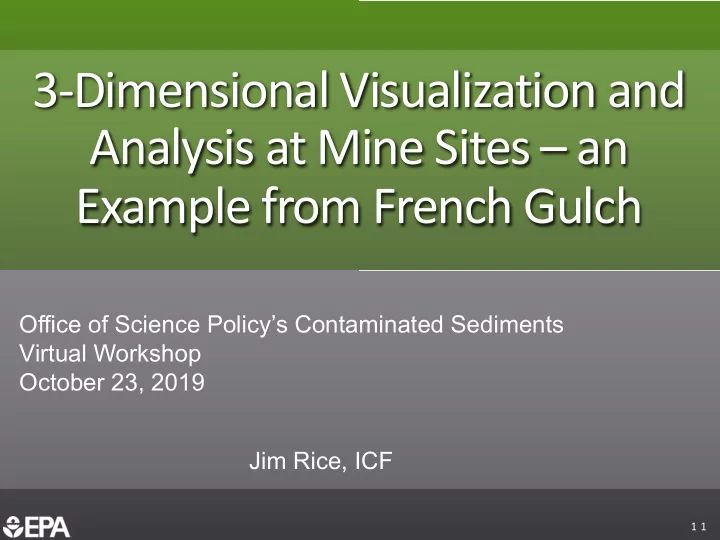

3-Dimensional Visualization and Analysis at Mine Sites – an Example from French Gulch Office of Science Policy’s Contaminated Sediments Virtual Workshop October 23, 2019 Jim Rice, ICF 1 1 -
Topics ♦ Site background and project needs ♦ Challenges and solutions ♦ Available data sets ♦ The final product » Site layout and features » Geology » Mine workings » Hydrology » Contaminant chemistry Note: All visualization products were prepared by Cascade Technical Services using C-Tech Studio EVS software. 1 2 -
Site Location and Setting To Dillon Reservoir (Denver DW Supply) 1 3 -
Site Location and Setting 1 4 -
Site Location and Setting 1 5 -
Site Overview • Wellington and Oro Mines – 1880’s to 1970’s • 12-miles of mine workings extending 800-feet in elevation, nearly 80% below valley floor • Lode and placer (dredge) mining, Pb and Zn ore also produced Cu, Ag and Au • Mine Influenced Water: French Creek • Blue River • Dillon Reservoir • Previous investigations conclude mine pool is primary source • Numerous seeps identified and sampled • Water treatment plant treats acid rock drainage collected at the site by pumping a natural seep named FG-6C • Fractured bedrock, faults, mine workings and connectivity with surface and groundwater • Faults = mineralized zones = ore bodies = sources = transport pathways 1 6 -
Project Objectives ♦ Construct a 3DVA to include » Mine site features: mine pool(s), mine workings, dredge mining operations, stream channels, fractures » Geology » Hydrogeology » Contaminant distribution ♦ Use the 3DVA to enable a more complete conceptualization of interconnecting parts (CSM) » Help make more informed decisions about where and how to investigate loading sources » Help identify and determine the feasibility of remedial alternatives ♦ Provide an additional tool for communicating site issues to stakeholders 1 7 -
3-D Visualization and Analysis Process ♦ Clarify Project Goals » Identify specific questions to be answered ♦ Manage Data » Address acquiring, reviewing, processing, importing ♦ Develop Component Databases and Visualizations » Components include geologic, hydrogeologic, and chemical ♦ Develop Integrated Visualizations » Integration of components with calibration and outlier checks ♦ Analyze Visualizations » Assess what 3-D visualizations depict ♦ Present Conclusions and Recommendations » Inform stakeholders and recommend next steps 5 8 -
AvailableData ♦ Mine features and geology » Primarily from 1934 USGS paper on the Breckenridge Mining District » No digital mine data » LiDAR data became available during project ♦ Hydrology » EPA and USGS investigations beginning 1980s; sporadic water level data ♦ Chemistry (groundwater and surface water) » Like the hydrology data somewhat sporadic » Focused on surface water data 1 9 -
Digitizing Mine Workings and Geology Using 5 Plates from 1934 USGS paper “Spaghetti” mine levels map Mine levels and geology 1 10 -
Digitizing Mine Workings and Geology Cross sections 1 11 -
Digitizing Mine Workings and Geology Placing cross sections and mine level maps in correct orientations 1 12 -
Digitizing Mine Workings and Geology Initial mine infrastructure component developed from plates 1 13 -
Digitizing Mine Workings and Geology ♦ Faults were an important component to the CSM ♦ Lots of faults at the site! ♦ Could they be visualized in a useful manner? 1 14 -
Digitizing Mine Workings and Geology Creating fault planes Example shows construction of the 11-10 fault from cross section data USGS fault map showed a different surface location of the 11-10 fault from the interpreted subsurface data 1 15 -
Digitizing Mine Workings and Geology Adding Stopes After initial review of the CSM, team thought that mined out areas would be helpful to see in the CSM Stope Maps from 1934 Paper and 1950 USGS Papers 1 16 -
Developing Overburden Geology Layer VE = 1:1 Alluvium depth/extent based on boring logs and USGS top and geologic maps Dredge material Bedrock Alluvium 1 17 -
Hydrology Potentiometric surface mapping Regular synoptic water readings February 1998 – August 2000 Water levels in the ORO mine appear to be rising? 1 18 -
Hydrology Question to be answered – What levels of the mine are flooded? 1 19 -
Surface Water Chemistry Seeps and surface water measurements over time Cadmium in stream Zinc in stream 1 20 -
Using Non-digital Data in the 3DVA Mine level elevation Fault location and orientation “Along French creek the depth to bedrock in the main channel…is 45 to 50 ft.” (Janin 1919 - January 25, 1919 mining journal documenting dredging operations in the valley ). 1 21 -
Data Not Included in the 3DVA Some important data for the CSM was not included in this visualization ♦ Hydrogeology » USGS tracer test studies (how to depict routes?) » Temperature data (limited spatial and temporal) » Flow and hydraulic conductivity data ♦ Geology » Extensive complex mineralogy could not be reasonably correlated between data points on cross sections » Level of detail not needed at this time » Monitoring well geologic data limited (depth and spatial) But some interpretations were used to support the visualization from 1995 report, “… pumping tests indicated… that the mine, shale, and alluvium are hydraulically connected, and they have similar head elevations.” and, “…there was drawdown in wells across the 11-10 fault…” 08-401469GW 4.1995 - Characterization FG Mine Pool Vol.1.pdf 1 22 -
Final Product ♦ Visualization package » Component models (mine workings, geology, hydrology and contaminants) in 4DIM format (free viewer) » Integrated visualization with key data from each component » Technical Memorandum to describe process and product ♦ Other useful products » Presentation to external stakeholders as a common platform of current site understanding » “Clean” database of well information and chemistry data to support EPA and USGS studies » 3D PDF for use in meetings, reports other communications 1 23 -
Final Product Switch to C-Tech Studio 4DIM Viewer to display integrated 4DIM 1 24 -
Recommend
More recommend